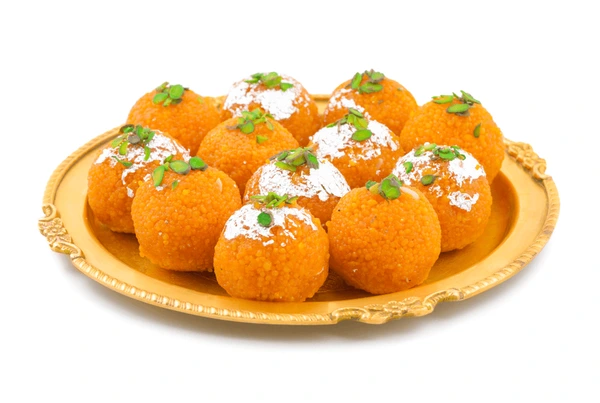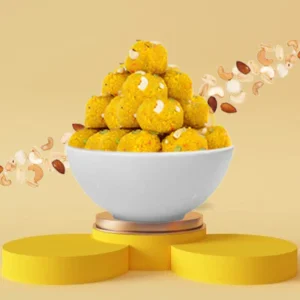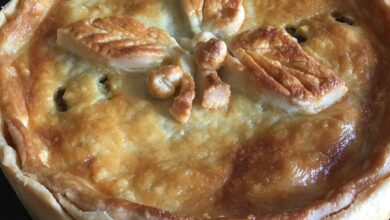Boondi Laddu Recipe
Boondi Laddu Recipe

Boondi Laddu Recipe Introduction:
Boondi Laddu is a traditional Indian sweet made from deep-fried gram flour (besan) droplets called “boondi,” which are then soaked in sugar syrup and shaped into round, melt-in-the-mouth laddus. This popular dessert is a festive favorite, particularly during celebrations like Diwali, weddings, and other special occasions.
The preparation involves making small, round boondis by dripping a batter of gram flour through a perforated ladle into hot oil, creating tiny, golden droplets. These boondis are then immersed in a spiced sugar syrup before being shaped into laddus and garnished with nuts and raisins. The result is a sweet, aromatic, and slightly crunchy treat with a soft and chewy interior, making it a beloved delicacy across India.

Boondi Laddu Recipe Overview:
This delightful treat is cherished for its sweet, syrup-soaked flavor and the crunchy texture of the boondi, making it a festive favorite in Indian cuisine.
Boondi Laddu Recipe Ingredients:
For the Boondi:
- Gram Flour (Besan): 1 cup
- Water: 1/2 to 3/4 cup (adjust as needed for batter consistency)
- Baking Soda: 1/4 teaspoon
- Turmeric Powder: 1/4 teaspoon (optional, for color)
- Salt: A pinch
- Ghee or Oil: For deep frying (about 2-3 cups, depending on the pan size)
For the Sugar Syrup:
- Sugar: 1 cup
- Water: 1/2 cup
- Cardamom Powder: 1/2 teaspoon
- Saffron Strands: A few (optional, for flavor and color)
- Rose Water: 1 teaspoon (optional)
For Garnishing:
- Chopped Nuts: 1/4 cup (such as almonds, cashews, or pistachios)
- Raisins: 2 tablespoons
- Chopped Coconut: 2 tablespoons (optional)
Boondi Laddu Recipe Ingredient Tips:
For the Boondi:
- Gram Flour (Besan):
-
- Quality: Use fine, sifted gram flour for smooth batter and uniform boondis. Fresh gram flour yields better results.
- Sifting: Sift the gram flour before mixing to remove any lumps and ensure a smooth batter.
- Water:
-
- Consistency: Add water gradually to achieve the right batter consistency. The batter should be thick enough to form droplets but thin enough to flow through the ladle.
- Baking Soda:
-
- Purpose: Baking soda helps in making the boondis crisp. Ensure it is fresh for best results.
- Turmeric Powder:
-
- Optional: Turmeric adds color but is optional. If you prefer a lighter color, you can skip it.
- Salt:
-
- Balance: A pinch of salt enhances the flavor of the boondi. Don’t skip it, as it balances the sweetness.
- Ghee or Oil:
-
- Choice: Ghee adds a richer flavor, while oil is more neutral. Choose based on your preference.
- Temperature: Maintain the oil temperature (medium heat) to fry the boondis evenly. Too hot oil can burn the boondis, while too cool oil will make them soggy.
For the Sugar Syrup:
- Sugar:
-
- Type: Regular granulated sugar works best. For a more nuanced flavor, you can use a mix of sugar and jaggery.
- Water:
-
- Consistency: The syrup should reach a one-string consistency. This ensures that the boondis absorb the right amount of syrup without becoming too soggy.
- Cardamom Powder:
-
- Freshness: Use freshly ground cardamom for the best aroma. Add it at the end of cooking to retain its flavor.
- Saffron Strands:
-
- Flavor and Color: Soak saffron strands in a tablespoon of warm milk before adding to the syrup to release its flavor and color.
- Rose Water:
-
- Optional: Adds a floral note. Use sparingly to avoid overpowering the flavor.
For Garnishing:
- Chopped Nuts:
-
- Roasting: Lightly roast the nuts before adding to enhance their flavor and crunch.
- Raisins:
-
- Plumping: If the raisins are dry, soak them in warm water for 10 minutes before adding to the laddu mixture to make them plump.
- Chopped Coconut:
-
- Optional: Adds a delightful texture. Toast the coconut lightly for a richer flavor.
Additional Tips:
- Batter Testing: Test a small amount of batter in hot oil to check for the right consistency before frying the entire batch. Adjust the batter if needed.
- Cooling: Allow the sugar syrup to cool slightly before adding the boondis to prevent the syrup from being too hot, which could make the boondis mushy.
- Shaping: Grease your hands with a little ghee when shaping the laddus to prevent sticking and to make shaping easier.
These tips will help you achieve perfectly crisp and flavorful Boondi Laddus with the right balance of sweetness and texture.
Boondi Laddu Recipe Equipment Needed:
- Mixing Bowls:
- For Batter: A large mixing bowl for preparing the boondi batter.
- For Syrup: A separate bowl for soaking the boondis in sugar syrup, if needed.
- Whisk or Spoon:
- For Mixing: To mix the gram flour with water and other ingredients to make a smooth batter.
- Perforated Ladle or Slotted Spoon:
- For Frying Boondi: A ladle with holes through which you will pour the batter to form small droplets in hot oil.
- Deep Frying Pan or Kadai:
- For Frying: A deep pan or wok with enough depth to submerge the boondis in oil.
- Slotted Spoon:
- For Draining: To remove the fried boondis from the oil and drain excess oil.
- Large Pan or Saucepan:
- For Sugar Syrup: A pan to prepare the sugar syrup. A non-stick pan or a heavy-bottomed saucepan is ideal to prevent burning.
- Thermometer (Optional):
- For Oil Temperature: To check the oil temperature for frying. This is optional but can help ensure the right temperature for frying boondis.
- Greased Tray or Plate:
- For Cooling and Setting: To place the boondis after frying and to let them cool slightly before mixing with syrup.
- Ladle or Spoon:
- For Shaping: To transfer the boondi mixture into laddus. A regular spoon or a ladle can be used for shaping the laddus.
- Knife or Spatula:
- For Mixing: To mix in the garnishes or stir the boondi mixture as needed.
- Greased Hands or Ghee:
- For Shaping: Grease your hands with a little ghee to shape the laddus easily and prevent sticking.
- Storage Containers:
- For Storing: Airtight containers for storing the Boondi Laddus once they have cooled and set.
These pieces of equipment will help you efficiently prepare, cook, and shape Boondi Laddu, ensuring a delicious and well-made sweet treat.
Boondi Laddu Recipe Step-by-Step Instructions:
1. Prepare the Boondi Batter:
- Mix Ingredients:
-
- In a large mixing bowl, combine 1 cup of gram flour (besan) with 1/4 teaspoon of baking soda and a pinch of salt.
- Gradually add 1/2 to 3/4 cup of water, whisking continuously to make a smooth batter. The batter should be thick enough to coat the back of a spoon but thin enough to drip through a perforated ladle.
- Add Turmeric Powder (Optional):
-
- If using, add 1/4 teaspoon of turmeric powder for color and mix well.
2. Heat the Oil:
- Prepare for Frying:
-
- Heat 2-3 cups of ghee or oil in a deep frying pan or kadai over medium heat. The oil should be deep enough to submerge the boondis.
- Test the Oil Temperature:
-
- To test if the oil is ready, drop a small amount of batter into the oil. It should float up immediately and sizzle without browning too quickly. Adjust the heat if needed.
3. Fry the Boondi:
- Fry Boondi:
- Hold a perforated ladle or slotted spoon over the hot oil. Pour a small amount of batter onto the ladle and let the batter drip through the holes into the hot oil, forming small droplets (boondis).
- Fry the boondis until they turn golden brown and crisp, but not too dark. Use a slotted spoon to remove them from the oil and drain on paper towels. Repeat with the remaining batter.
4. Prepare the Sugar Syrup:
- Make Syrup:
-
- In a large pan, combine 1 cup of sugar with 1/2 cup of water. Heat over medium flame, stirring until the sugar dissolves.
- Continue heating the syrup until it reaches a one-string consistency. To check, take a drop of syrup between your fingers and pull apart; it should form a single thread.
- Add Flavorings:
-
- Once the syrup reaches the desired consistency, add 1/2 teaspoon of cardamom powder, a few saffron strands (if using), and 1 teaspoon of rose water (if using). Stir well.
5. Combine Boondi and Syrup:
- Mix Boondi with Syrup:
- Add the fried boondis to the hot sugar syrup. Stir gently to ensure that all the boondis are well-coated with syrup.
- Let the boondis soak in the syrup for about 10-15 minutes. They should absorb the syrup and become soft.
6. Shape the Laddus:
- Prepare for Shaping:
-
- Grease your hands with a little ghee to prevent the mixture from sticking.
- Form Laddus:
-
- Take small portions of the syrup-soaked boondi and press them firmly between your palms to shape into round laddus. If the mixture is too sticky, let it cool slightly before shaping.
7. Garnish and Cool:
- Add Garnishes:
-
- While the laddus are still warm, press chopped nuts (such as almonds, cashews) and raisins into the top of each laddu. You can also sprinkle chopped coconut if desired.
- Cool Completely:
-
- Allow the laddus to cool completely at room temperature. They will firm up as they cool.
8. Store and Serve:
- Storage:
-
- Store the Boondi Laddus in an airtight container at room temperature for up to a week. For longer storage, you can refrigerate them.
- Serve:
-
- Serve the Boondi Laddus as a festive treat or dessert. Enjoy them with family and friends during special occasions and celebrations.
Boondi Laddu Recipe Tips and Tricks:
1. Batter Consistency:
- Check Consistency: The batter should be smooth and slightly thick, but not too thick or runny. It should flow easily through the perforated ladle without clumping.
- Adjust Thickness: If the batter is too thick, add a little water. If too thin, add a bit more gram flour.
2. Frying Tips:
- Oil Temperature: Maintain medium heat. If the oil is too hot, the boondis will brown too quickly and become crispy. If too cool, they’ll be soggy.
- Test the Oil: Drop a small amount of batter into the oil to check the temperature. The batter should sizzle and rise to the surface quickly.
- Fry in Batches: Fry the boondis in small batches to avoid overcrowding the pan, which can lower the oil temperature and lead to uneven cooking.
3. Making the Boondi:
- Ladle Technique: Use a perforated ladle or slotted spoon to pour the batter into the oil. Hold it a few inches above the surface to create small, uniform droplets.
- Avoid Overcrowding: Don’t overfill the ladle; this will help the boondis fry evenly and prevent them from sticking together.
4. Sugar Syrup:
- One-String Consistency: Ensure the syrup reaches a one-string consistency for proper soaking. If it’s too thin, it won’t coat the boondis well; if too thick, the boondis will be dry.
- Flavorings: Add cardamom, saffron, or rose water to enhance the flavor, but do so sparingly to avoid overpowering the taste.
5. Combining Boondi and Syrup:
- Syrup Temperature: The syrup should be hot when you add the boondis, but not boiling. This ensures the boondis absorb the syrup properly without becoming too soggy.
- Mix Gently: Stir the boondis gently in the syrup to coat them without breaking them. Allow them to soak for the right amount of time to absorb enough syrup.
6. Shaping the Laddus:
- Cool Slightly: If the mixture is too hot, let it cool slightly before shaping to avoid burning your hands.
- Grease Hands: Grease your hands with ghee to prevent sticking and make shaping easier.
- Press Firmly: Shape the laddus firmly to ensure they hold together. If they are too soft or crumbly, they may need more time to cool and set.
7. Storage:
- Airtight Container: Store the laddus in an airtight container to keep them fresh and prevent them from drying out.
- Room Temperature: Keep them at room temperature for up to a week. For longer storage, you can refrigerate them, though they might become a bit firmer.
8. Troubleshooting:
- Sticky Mixture: If the mixture is too sticky and difficult to shape, let it cool down and thicken a bit more before forming into laddus.
- Dry Laddus: If the laddus are dry, the syrup may have been too thick or the boondis may have been overcooked. To salvage, you can lightly reheat them in the microwave or steam them briefly to soften.
Serving Suggestions:
**1. Traditional Presentation:
- Festive Platter: Arrange Boondi Laddus on a decorative platter or tray. Garnish with additional chopped nuts or a sprinkle of edible gold or silver leaves for an elegant touch, especially during festivals like Diwali or weddings.
**2. With Tea or Coffee:
- Tea Time Treat: Serve Boondi Laddus as a sweet accompaniment to a cup of tea or coffee. Their rich, sugary flavor pairs wonderfully with a hot beverage.
**3. During Special Occasions:
- Celebratory Sweet: Offer Boondi Laddus during special occasions such as birthdays, weddings, and religious ceremonies. They make a perfect sweet treat for guests.
**4. As a Gift:
- Gift Packs: Pack Boondi Laddus in decorative boxes or jars to give as gifts. They make a thoughtful and cherished gift for friends and family during festivals and special events.
**5. With Other Desserts:
- Dessert Platter: Include Boondi Laddus on a dessert platter along with other Indian sweets like Gulab Jamun, Jalebi, or Kaju Katli. This assortment offers a variety of flavors and textures.
**6. With Fruits and Nuts:
- Fruit and Nut Pairing: Serve Boondi Laddus with a side of fresh fruit or a mixed nut platter. The combination of sweet laddus with fresh, seasonal fruits or crunchy nuts creates a balanced and satisfying treat.
**7. As a Sweet Ending to a Meal:
- Post-Meal Delight: Enjoy Boondi Laddus as a sweet ending to a traditional Indian meal. They are a great way to round off a hearty meal with a touch of sweetness.
**8. With Yogurt or Cream:
- Yogurt Dish: For a richer dessert, serve Boondi Laddus with a dollop of yogurt or cream. This adds a creamy element that complements the sweet and slightly chewy laddus.
**9. With Warm Milk:
- Milk Pairing: Pair Boondi Laddus with a glass of warm milk for a comforting and wholesome treat. This combination is particularly soothing and satisfying.
**10. For Picnics and Potlucks:
- Portable Treat: Boondi Laddus are easy to pack and transport, making them an excellent choice for picnics, potlucks, or outdoor gatherings.
FAQs:
1. What is the ideal batter consistency for Boondi Laddu?
Answer: The batter should be smooth and slightly thick, similar to pancake batter. It should be thick enough to form droplets but thin enough to flow easily through the perforated ladle. Adjust the water as needed to achieve this consistency.
2. How can I prevent the boondis from sticking together while frying?
Answer: Ensure that the oil is hot enough but not smoking. If the oil temperature is too low, the boondis will absorb more oil and stick together. Fry the boondis in small batches to avoid overcrowding, which helps them cook evenly and separately.
3. How do I know when the sugar syrup is at the right consistency?
Answer: The syrup should reach a one-string consistency, where a drop of syrup forms a single thread when tested between your fingers. To test, take a drop of syrup on the back of a spoon and let it cool slightly; it should form a thread when pulled apart.
4. What if the boondis become too soft after soaking in the syrup?
Answer: If the boondis become too soft, they may have been soaked in the syrup for too long. Ensure you soak them just long enough to absorb the syrup without becoming mushy. If they are too soft, let them cool and firm up before shaping.
5. Can I make Boondi Laddu in advance and store them?
Answer: Yes, you can make Boondi Laddu in advance. Store them in an airtight container at room temperature for up to a week. For longer storage, you can refrigerate them, but they might become slightly firmer.





